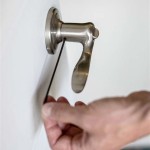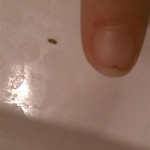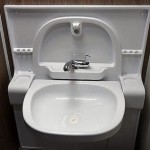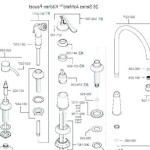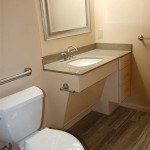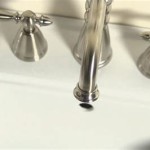How To Fix a Bathroom Sink Slow Drain
A slow-draining bathroom sink is a common household problem that can range from a minor inconvenience to a sign of a more significant plumbing issue. Understanding the potential causes and knowing how to address them can save time, money, and the frustration of dealing with standing water. This article provides a comprehensive guide to diagnosing and resolving slow drain issues in bathroom sinks.
The first step in fixing a slow drain is to identify the potential culprits. Common causes include hair accumulation, soap scum buildup, mineral deposits, and obstructions in the drainpipe. These blockages can restrict water flow, leading to a gradual decrease in drainage speed. Ignoring a slow drain can exacerbate the problem, leading to a complete blockage and requiring more extensive repairs.
Identifying the Cause of a Slow Drain
Before attempting any fixes, a thorough assessment of the situation is crucial. This involves observing the sink and the surrounding area for any obvious signs of the problem. Listen for gurgling sounds when the water drains, which can indicate a partial blockage. Inspect the pop-up stopper for hair or debris accumulation. Also, check the area under the sink for any signs of leaks or corrosion, which could point to a more serious plumbing issue.
The age of the plumbing system can also be a factor. Older pipes, particularly those made of galvanized steel, are more prone to corrosion and mineral buildup, which can significantly reduce the internal diameter of the pipe and restrict water flow. Newer PVC pipes are less susceptible to these issues but can still be affected by hair and soap scum buildup.
Another factor to consider is the types of products used in the sink. Certain soaps, shampoos, and toothpaste can contribute to the buildup of residue in the drainpipe. Switching to different products or using drain cleaners regularly can help prevent future blockages.
DIY Methods for Clearing a Slow Drain
Several do-it-yourself methods can be employed to clear a slow drain. These methods range from simple solutions using household items to more involved techniques that require basic tools. It's recommended to start with the least intrusive methods and progress to more complex solutions if necessary.
Using Hot Water: Often, a simple solution is the most effective. Boiling water can help dissolve soap scum and loosen minor blockages. Carefully pour a kettle of boiling water down the drain. Exercise caution when handling boiling water to avoid burns. This method is most effective for drains that are only partially blocked and may not work for more severe obstructions. It is crucial to avoid pouring boiling water down PVC pipes as the heat may damage the plastic and cause it to warp and melt.
Baking Soda and Vinegar: This is a natural and environmentally friendly alternative to chemical drain cleaners. Pour one cup of baking soda down the drain, followed by one cup of vinegar. Let the mixture fizz for about 30 minutes, then flush with hot water. The chemical reaction between baking soda and vinegar helps to break down grease and other organic matter. This method can be repeated if necessary.
Plunging the Drain: A standard plunger can be effective for dislodging blockages. Ensure there is enough water in the sink to cover the cup of the plunger. Create a tight seal around the drain opening and plunge vigorously up and down for several minutes. Remove the plunger and check if the water drains freely. Repeat the process if needed. For sinks with overflows, it's important to block the overflow opening with a damp cloth to create a better seal and increase the effectiveness of the plunging.
Cleaning the Pop-Up Stopper: The pop-up stopper is a common area for hair and debris to accumulate. To clean it, remove the stopper from the drain. This usually involves loosening a nut or screw located beneath the sink. Once the stopper is removed, clean it thoroughly with a brush or cloth, removing any hair or debris. Reinstall the stopper and test the drain.
Advanced Techniques and When to Call a Professional
If the DIY methods prove ineffective, more advanced techniques may be required. These techniques involve using specialized tools and may require some plumbing knowledge. If unsure about performing these steps, it's best to consult a professional plumber.
Using a Drain Snake: A drain snake, also known as a plumbing snake or auger, is a flexible tool used to break up or retrieve blockages deep within the drainpipe. Insert the snake into the drain opening and carefully feed it down the pipe, rotating it as you go. If you encounter resistance, continue rotating the snake to break up the blockage or hook onto it. Once you feel the blockage dislodge, slowly retract the snake, removing any debris. Flush the drain with hot water to ensure it is clear.
Checking the P-Trap: The P-trap is a U-shaped section of pipe located beneath the sink. Its purpose is to trap debris and prevent sewer gases from entering the home. However, it can also become clogged with hair, soap scum, and other materials. To clean the P-trap, place a bucket underneath to catch any water. Loosen the slip nuts connecting the P-trap to the drainpipes. Carefully remove the P-trap and empty its contents into the bucket. Clean the P-trap thoroughly with a brush and hot water. Reinstall the P-trap, ensuring the slip nuts are tightened securely. Test the drain for leaks.
Chemical Drain Cleaners: While chemical drain cleaners can be effective in dissolving certain types of blockages, they should be used with caution. These cleaners contain harsh chemicals that can damage pipes, especially older ones. Additionally, they can be harmful to the environment and pose a safety risk if not handled properly. Always follow the manufacturer's instructions carefully and wear protective gloves and eyewear. Avoid using chemical drain cleaners as a first resort; they are best used as a last resort when other methods have failed. Frequent use of chemical drain cleaners can cause long-term damage to the plumbing system.
Video Inspection: For persistent or recurring slow drain issues, a video inspection can be beneficial. This involves using a small camera to inspect the inside of the drainpipe for any hidden blockages or damage. This method can help identify issues that are not visible from the surface, such as collapsed pipes or root intrusion. Video inspections are typically performed by professional plumbers and can provide valuable information for diagnosing and resolving complex plumbing problems.
When to Call a Professional Plumber: There are situations where it is best to call a professional plumber. These include:
*If the DIY methods are unsuccessful in clearing the drain.
*If there are signs of a more serious plumbing problem, such as leaks or corrosion.
*If the slow drain is accompanied by other plumbing issues, such as low water pressure or sewage backups.
*If there is a suspected blockage in the main sewer line.
Attempting to fix a complex plumbing problem without the necessary knowledge and equipment can lead to further damage and costly repairs. A professional plumber has the expertise, tools, and experience to diagnose and resolve plumbing issues safely and effectively.
Preventing Future Slow Drains
Preventing slow drains is easier and more cost-effective than fixing them. Implementing a few simple habits can help keep bathroom sink drains clear and prevent future blockages.
Using a Drain Screen: A drain screen or strainer is a simple device that fits over the drain opening and catches hair and other debris before they enter the drainpipe. This is one of the most effective ways to prevent clogs. Regularly clean the drain screen to remove accumulated debris.
Flushing the Drain Regularly: Periodically flushing the drain with hot water can help dissolve soap scum and prevent buildup. Do this at least once a week. Run hot water down the drain for several minutes to keep the pipes clear.
Avoiding Grease and Oil: Never pour grease or oil down the drain. These substances can solidify in the pipes and cause blockages. Dispose of grease and oil in a separate container and discard it properly.
Using Enzyme Drain Cleaners: Enzyme drain cleaners are a natural and environmentally friendly alternative to chemical drain cleaners. They contain enzymes that break down organic matter without damaging the pipes. Use enzyme drain cleaners regularly to help prevent buildup.
Regular Plumbing Maintenance: Schedule regular plumbing maintenance to identify and address potential issues before they become major problems. A professional plumber can inspect the plumbing system and provide recommendations for preventing clogs and other plumbing issues.

How You Can Fix A Slow Draining Drain On Your Own Call Ashton Plumbing

How To Unclog A Slow Running Bathroom Sink Drain 10 Options

How To Unclog A Slow Running Bathroom Sink Drain 10 Options

How To Unclog A Bathroom Sink Hana S Happy Home

Slow Sink Drain 6 Diy Fixes For Before You Call A Plumber Bob Vila

How To Unclog A Bathroom Sink The Home Depot

5 Natural Ways To Unclog A Bathroom Sink Hiller How

Slow Sink Drain 6 Diy Fixes For Before You Call A Plumber Bob Vila

How To Unclog A Bathroom Sink Hana S Happy Home

4 Tips To Fix A Slow Draining Sink
Related Posts
